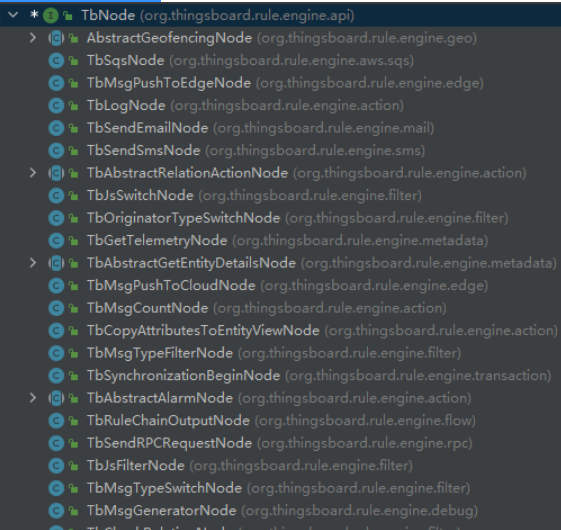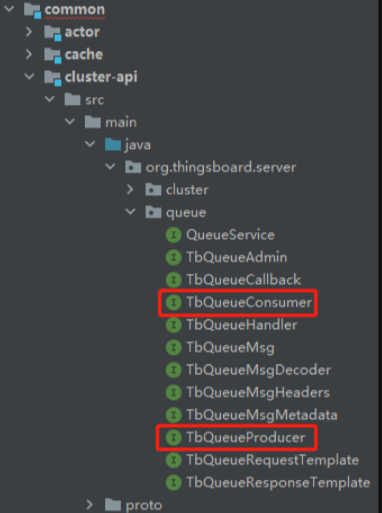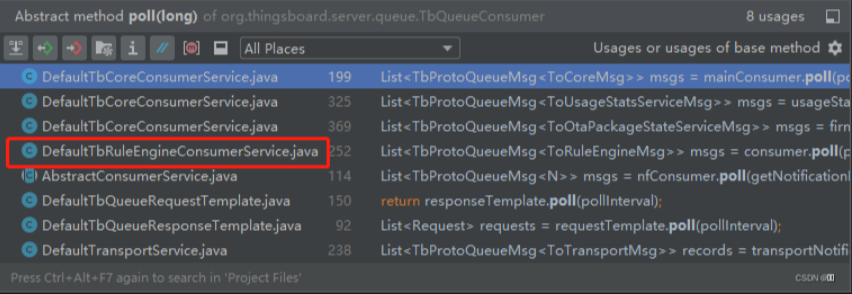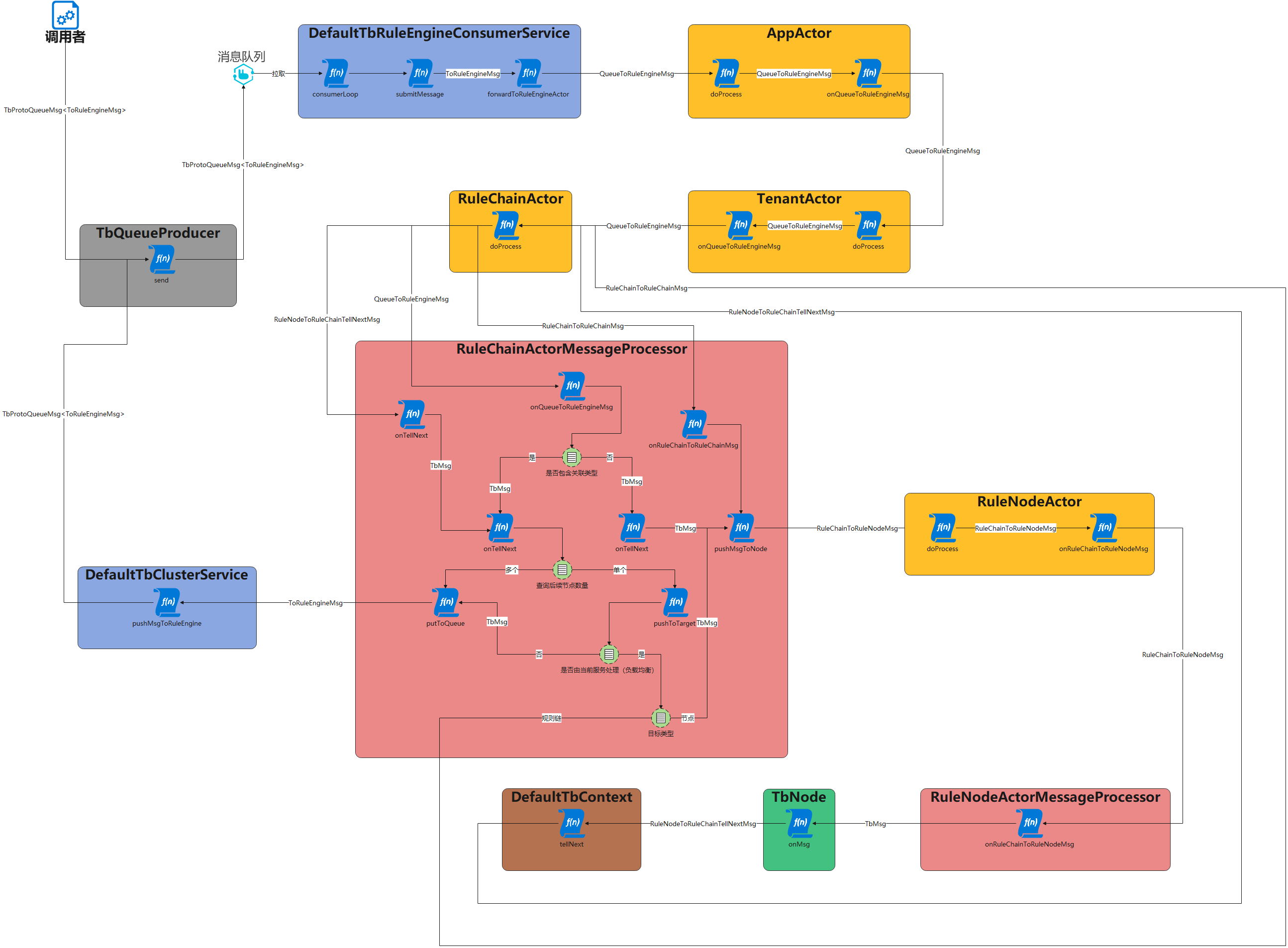ThingsBoard源码解析-数据订阅与规则链数据处理
- thingsboard
- 时间:2023-05-04 18:11
- 3110人已阅读
🔔🔔好消息!好消息!🔔🔔
如果您需要注册ChatGPT,想要升级ChatGPT4。凯哥可以代注册ChatGPT账号,代升级ChatGPT4
有需要的朋友👉:微信号
前言
//org.thingsboard.server.transport.mqtt.MqttTransportHandler
void processRegularSessionMsg(ChannelHandlerContext ctx, MqttMessage msg) {
switch (msg.fixedHeader().messageType()) {
case PUBLISH:
processPublish(ctx, (MqttPublishMessage) msg);
break;
case SUBSCRIBE:
processSubscribe(ctx, (MqttSubscribeMessage) msg);
break;
case UNSUBSCRIBE:
processUnsubscribe(ctx, (MqttUnsubscribeMessage) msg);
break;
case PINGREQ:
if (checkConnected(ctx, msg)) {
ctx.writeAndFlush(new MqttMessage(new MqttFixedHeader(PINGRESP, false, AT_MOST_ONCE, false, 0)));
transportService.reportActivity(deviceSessionCtx.getSessionInfo());
}
break;
case DISCONNECT:
ctx.close();
break;
case PUBACK:
int msgId = ((MqttPubAckMessage) msg).variableHeader().messageId();
TransportProtos.ToDeviceRpcRequestMsg rpcRequest = rpcAwaitingAck.remove(msgId);
if (rpcRequest != null) {
transportService.process(deviceSessionCtx.getSessionInfo(), rpcRequest, RpcStatus.DELIVERED, TransportServiceCallback.EMPTY);
}
break;
default:
break;
}
}//org.thingsboard.server.transport.mqtt.MqttTransportHandler
private void processPublish(ChannelHandlerContext ctx, MqttPublishMessage mqttMsg) {
if (!checkConnected(ctx, mqttMsg)) {
return;
}
String topicName = mqttMsg.variableHeader().topicName();
int msgId = mqttMsg.variableHeader().packetId();
log.trace("[{}][{}] Processing publish msg [{}][{}]!", sessionId, deviceSessionCtx.getDeviceId(), topicName, msgId);
if (topicName.startsWith(MqttTopics.BASE_GATEWAY_API_TOPIC)) {
//消息来源为网关主题
if (gatewaySessionHandler != null) {
handleGatewayPublishMsg(ctx, topicName, msgId, mqttMsg);
transportService.reportActivity(deviceSessionCtx.getSessionInfo());
}
} else {
//处理设备的消息,重点
processDevicePublish(ctx, mqttMsg, topicName, msgId);
}
}//org.thingsboard.server.transport.mqtt.MqttTransportHandler
private void processDevicePublish(ChannelHandlerContext ctx, MqttPublishMessage mqttMsg, String topicName, int msgId) {
try {
Matcher fwMatcher;
MqttTransportAdaptor payloadAdaptor = deviceSessionCtx.getPayloadAdaptor();
if (deviceSessionCtx.isDeviceAttributesTopic(topicName)) {
TransportProtos.PostAttributeMsg postAttributeMsg = payloadAdaptor.convertToPostAttributes(deviceSessionCtx, mqttMsg);
transportService.process(deviceSessionCtx.getSessionInfo(), postAttributeMsg, getPubAckCallback(ctx, msgId, postAttributeMsg));
} else if (deviceSessionCtx.isDeviceTelemetryTopic(topicName)) {
TransportProtos.PostTelemetryMsg postTelemetryMsg = payloadAdaptor.convertToPostTelemetry(deviceSessionCtx, mqttMsg);
transportService.process(deviceSessionCtx.getSessionInfo(), postTelemetryMsg, getPubAckCallback(ctx, msgId, postTelemetryMsg));
} else if (topicName.startsWith(MqttTopics.DEVICE_ATTRIBUTES_REQUEST_TOPIC_PREFIX)) {
TransportProtos.GetAttributeRequestMsg getAttributeMsg = payloadAdaptor.convertToGetAttributes(deviceSessionCtx, mqttMsg, MqttTopics.DEVICE_ATTRIBUTES_REQUEST_TOPIC_PREFIX);
transportService.process(deviceSessionCtx.getSessionInfo(), getAttributeMsg, getPubAckCallback(ctx, msgId, getAttributeMsg));
attrReqTopicType = TopicType.V1;
} else if (topicName.startsWith(MqttTopics.DEVICE_RPC_RESPONSE_TOPIC)) {
TransportProtos.ToDeviceRpcResponseMsg rpcResponseMsg = payloadAdaptor.convertToDeviceRpcResponse(deviceSessionCtx, mqttMsg, MqttTopics.DEVICE_RPC_RESPONSE_TOPIC);
transportService.process(deviceSessionCtx.getSessionInfo(), rpcResponseMsg, getPubAckCallback(ctx, msgId, rpcResponseMsg));
} else if (topicName.startsWith(MqttTopics.DEVICE_RPC_REQUESTS_TOPIC)) {
TransportProtos.ToServerRpcRequestMsg rpcRequestMsg = payloadAdaptor.convertToServerRpcRequest(deviceSessionCtx, mqttMsg, MqttTopics.DEVICE_RPC_REQUESTS_TOPIC);
transportService.process(deviceSessionCtx.getSessionInfo(), rpcRequestMsg, getPubAckCallback(ctx, msgId, rpcRequestMsg));
toServerRpcSubTopicType = TopicType.V1;
} else if (topicName.equals(MqttTopics.DEVICE_CLAIM_TOPIC)) {
TransportProtos.ClaimDeviceMsg claimDeviceMsg = payloadAdaptor.convertToClaimDevice(deviceSessionCtx, mqttMsg);
transportService.process(deviceSessionCtx.getSessionInfo(), claimDeviceMsg, getPubAckCallback(ctx, msgId, claimDeviceMsg));
} else if ((fwMatcher = FW_REQUEST_PATTERN.matcher(topicName)).find()) {
getOtaPackageCallback(ctx, mqttMsg, msgId, fwMatcher, OtaPackageType.FIRMWARE);
} else if ((fwMatcher = SW_REQUEST_PATTERN.matcher(topicName)).find()) {
getOtaPackageCallback(ctx, mqttMsg, msgId, fwMatcher, OtaPackageType.SOFTWARE);
} else if (topicName.equals(MqttTopics.DEVICE_TELEMETRY_SHORT_TOPIC)) {
TransportProtos.PostTelemetryMsg postTelemetryMsg = payloadAdaptor.convertToPostTelemetry(deviceSessionCtx, mqttMsg);
transportService.process(deviceSessionCtx.getSessionInfo(), postTelemetryMsg, getPubAckCallback(ctx, msgId, postTelemetryMsg));
} else if (topicName.equals(MqttTopics.DEVICE_TELEMETRY_SHORT_JSON_TOPIC)) {
TransportProtos.PostTelemetryMsg postTelemetryMsg = context.getJsonMqttAdaptor().convertToPostTelemetry(deviceSessionCtx, mqttMsg);
transportService.process(deviceSessionCtx.getSessionInfo(), postTelemetryMsg, getPubAckCallback(ctx, msgId, postTelemetryMsg));
} else if (topicName.equals(MqttTopics.DEVICE_TELEMETRY_SHORT_PROTO_TOPIC)) {
TransportProtos.PostTelemetryMsg postTelemetryMsg = context.getProtoMqttAdaptor().convertToPostTelemetry(deviceSessionCtx, mqttMsg);
transportService.process(deviceSessionCtx.getSessionInfo(), postTelemetryMsg, getPubAckCallback(ctx, msgId, postTelemetryMsg));
} else if (topicName.equals(MqttTopics.DEVICE_ATTRIBUTES_SHORT_TOPIC)) {
TransportProtos.PostAttributeMsg postAttributeMsg = payloadAdaptor.convertToPostAttributes(deviceSessionCtx, mqttMsg);
transportService.process(deviceSessionCtx.getSessionInfo(), postAttributeMsg, getPubAckCallback(ctx, msgId, postAttributeMsg));
} else if (topicName.equals(MqttTopics.DEVICE_ATTRIBUTES_SHORT_JSON_TOPIC)) {
TransportProtos.PostAttributeMsg postAttributeMsg = context.getJsonMqttAdaptor().convertToPostAttributes(deviceSessionCtx, mqttMsg);
transportService.process(deviceSessionCtx.getSessionInfo(), postAttributeMsg, getPubAckCallback(ctx, msgId, postAttributeMsg));
} else if (topicName.equals(MqttTopics.DEVICE_ATTRIBUTES_SHORT_PROTO_TOPIC)) {
TransportProtos.PostAttributeMsg postAttributeMsg = context.getProtoMqttAdaptor().convertToPostAttributes(deviceSessionCtx, mqttMsg);
transportService.process(deviceSessionCtx.getSessionInfo(), postAttributeMsg, getPubAckCallback(ctx, msgId, postAttributeMsg));
} else if (topicName.startsWith(MqttTopics.DEVICE_RPC_RESPONSE_SHORT_JSON_TOPIC)) {
TransportProtos.ToDeviceRpcResponseMsg rpcResponseMsg = context.getJsonMqttAdaptor().convertToDeviceRpcResponse(deviceSessionCtx, mqttMsg, MqttTopics.DEVICE_RPC_RESPONSE_SHORT_JSON_TOPIC);
transportService.process(deviceSessionCtx.getSessionInfo(), rpcResponseMsg, getPubAckCallback(ctx, msgId, rpcResponseMsg));
} else if (topicName.startsWith(MqttTopics.DEVICE_RPC_RESPONSE_SHORT_PROTO_TOPIC)) {
TransportProtos.ToDeviceRpcResponseMsg rpcResponseMsg = context.getProtoMqttAdaptor().convertToDeviceRpcResponse(deviceSessionCtx, mqttMsg, MqttTopics.DEVICE_RPC_RESPONSE_SHORT_PROTO_TOPIC);
transportService.process(deviceSessionCtx.getSessionInfo(), rpcResponseMsg, getPubAckCallback(ctx, msgId, rpcResponseMsg));
} else if (topicName.startsWith(MqttTopics.DEVICE_RPC_RESPONSE_SHORT_TOPIC)) {
TransportProtos.ToDeviceRpcResponseMsg rpcResponseMsg = payloadAdaptor.convertToDeviceRpcResponse(deviceSessionCtx, mqttMsg, MqttTopics.DEVICE_RPC_RESPONSE_SHORT_TOPIC);
transportService.process(deviceSessionCtx.getSessionInfo(), rpcResponseMsg, getPubAckCallback(ctx, msgId, rpcResponseMsg));
} else if (topicName.startsWith(MqttTopics.DEVICE_RPC_REQUESTS_SHORT_JSON_TOPIC)) {
TransportProtos.ToServerRpcRequestMsg rpcRequestMsg = context.getJsonMqttAdaptor().convertToServerRpcRequest(deviceSessionCtx, mqttMsg, MqttTopics.DEVICE_RPC_REQUESTS_SHORT_JSON_TOPIC);
transportService.process(deviceSessionCtx.getSessionInfo(), rpcRequestMsg, getPubAckCallback(ctx, msgId, rpcRequestMsg));
toServerRpcSubTopicType = TopicType.V2_JSON;
} else if (topicName.startsWith(MqttTopics.DEVICE_RPC_REQUESTS_SHORT_PROTO_TOPIC)) {
TransportProtos.ToServerRpcRequestMsg rpcRequestMsg = context.getProtoMqttAdaptor().convertToServerRpcRequest(deviceSessionCtx, mqttMsg, MqttTopics.DEVICE_RPC_REQUESTS_SHORT_PROTO_TOPIC);
transportService.process(deviceSessionCtx.getSessionInfo(), rpcRequestMsg, getPubAckCallback(ctx, msgId, rpcRequestMsg));
toServerRpcSubTopicType = TopicType.V2_PROTO;
} else if (topicName.startsWith(MqttTopics.DEVICE_RPC_REQUESTS_SHORT_TOPIC)) {
TransportProtos.ToServerRpcRequestMsg rpcRequestMsg = payloadAdaptor.convertToServerRpcRequest(deviceSessionCtx, mqttMsg, MqttTopics.DEVICE_RPC_REQUESTS_SHORT_TOPIC);
transportService.process(deviceSessionCtx.getSessionInfo(), rpcRequestMsg, getPubAckCallback(ctx, msgId, rpcRequestMsg));
toServerRpcSubTopicType = TopicType.V2;
} else if (topicName.startsWith(MqttTopics.DEVICE_ATTRIBUTES_REQUEST_SHORT_JSON_TOPIC_PREFIX)) {
TransportProtos.GetAttributeRequestMsg getAttributeMsg = context.getJsonMqttAdaptor().convertToGetAttributes(deviceSessionCtx, mqttMsg, MqttTopics.DEVICE_ATTRIBUTES_REQUEST_SHORT_JSON_TOPIC_PREFIX);
transportService.process(deviceSessionCtx.getSessionInfo(), getAttributeMsg, getPubAckCallback(ctx, msgId, getAttributeMsg));
attrReqTopicType = TopicType.V2_JSON;
} else if (topicName.startsWith(MqttTopics.DEVICE_ATTRIBUTES_REQUEST_SHORT_PROTO_TOPIC_PREFIX)) {
TransportProtos.GetAttributeRequestMsg getAttributeMsg = context.getProtoMqttAdaptor().convertToGetAttributes(deviceSessionCtx, mqttMsg, MqttTopics.DEVICE_ATTRIBUTES_REQUEST_SHORT_PROTO_TOPIC_PREFIX);
transportService.process(deviceSessionCtx.getSessionInfo(), getAttributeMsg, getPubAckCallback(ctx, msgId, getAttributeMsg));
attrReqTopicType = TopicType.V2_PROTO;
} else if (topicName.startsWith(MqttTopics.DEVICE_ATTRIBUTES_REQUEST_SHORT_TOPIC_PREFIX)) {
TransportProtos.GetAttributeRequestMsg getAttributeMsg = payloadAdaptor.convertToGetAttributes(deviceSessionCtx, mqttMsg, MqttTopics.DEVICE_ATTRIBUTES_REQUEST_SHORT_TOPIC_PREFIX);
transportService.process(deviceSessionCtx.getSessionInfo(), getAttributeMsg, getPubAckCallback(ctx, msgId, getAttributeMsg));
attrReqTopicType = TopicType.V2;
} else {
transportService.reportActivity(deviceSessionCtx.getSessionInfo());
ack(ctx, msgId);
}
} catch (AdaptorException e) {
log.debug("[{}] Failed to process publish msg [{}][{}]", sessionId, topicName, msgId, e);
log.info("[{}] Closing current session due to invalid publish msg [{}][{}]", sessionId, topicName, msgId);
ctx.close();
}
}这里根据消息来源主题的不同,进行对应的处理
顺着属性消息处理继续往下看
//org.thingsboard.server.common.transport.service.DefaultTransportService
@Override
public void process(TransportProtos.SessionInfoProto sessionInfo, TransportProtos.PostAttributeMsg msg, TransportServiceCallback<Void> callback) {
if (checkLimits(sessionInfo, msg, callback, msg.getKvCount())) {
//更新活动时间
reportActivityInternal(sessionInfo);
TenantId tenantId = getTenantId(sessionInfo);
DeviceId deviceId = new DeviceId(new UUID(sessionInfo.getDeviceIdMSB(), sessionInfo.getDeviceIdLSB()));
//获取键值对
JsonObject json = JsonUtils.getJsonObject(msg.getKvList());
//构造元数据
TbMsgMetaData metaData = new TbMsgMetaData();
metaData.putValue("deviceName", sessionInfo.getDeviceName());
metaData.putValue("deviceType", sessionInfo.getDeviceType());
metaData.putValue("notifyDevice", "false");
CustomerId customerId = getCustomerId(sessionInfo);
//发送至规则引擎
sendToRuleEngine(tenantId, deviceId, customerId, sessionInfo, json, metaData, SessionMsgType.POST_ATTRIBUTES_REQUEST,
new TransportTbQueueCallback(new ApiStatsProxyCallback<>(tenantId, customerId, msg.getKvList().size(), callback)));
}
}//org.thingsboard.server.common.transport.service.DefaultTransportService
private void sendToRuleEngine(TenantId tenantId, DeviceId deviceId, CustomerId customerId, TransportProtos.SessionInfoProto sessionInfo, JsonObject json,
TbMsgMetaData metaData, SessionMsgType sessionMsgType, TbQueueCallback callback) {
//创建设备配置标识
DeviceProfileId deviceProfileId = new DeviceProfileId(new UUID(sessionInfo.getDeviceProfileIdMSB(), sessionInfo.getDeviceProfileIdLSB()));
//从缓存中获取设备配置
DeviceProfile deviceProfile = deviceProfileCache.get(deviceProfileId);
RuleChainId ruleChainId;
String queueName;
if (deviceProfile == null) {
//无设备配置,使用默认的规则链和队列名
log.warn("[{}] Device profile is null!", deviceProfileId);
ruleChainId = null;
queueName = ServiceQueue.MAIN;
} else {
//获取规则链标识
ruleChainId = deviceProfile.getDefaultRuleChainId();
//获取队列名
String defaultQueueName = deviceProfile.getDefaultQueueName();
queueName = defaultQueueName != null ? defaultQueueName : ServiceQueue.MAIN;
}
//创建消息
TbMsg tbMsg = TbMsg.newMsg(queueName, sessionMsgType.name(), deviceId, customerId, metaData, gson.toJson(json), ruleChainId, null);
//发送至规则引擎
sendToRuleEngine(tenantId, tbMsg, callback);
}//org.thingsboard.server.common.transport.service.DefaultTransportService
private void sendToRuleEngine(TenantId tenantId, TbMsg tbMsg, TbQueueCallback callback) {
//获取分区信息
TopicPartitionInfo tpi = partitionService.resolve(ServiceType.TB_RULE_ENGINE, tbMsg.getQueueName(), tenantId, tbMsg.getOriginator());
if (log.isTraceEnabled()) {
log.trace("[{}][{}] Pushing to topic {} message {}", tenantId, tbMsg.getOriginator(), tpi.getFullTopicName(), tbMsg);
}
//创建消息
ToRuleEngineMsg msg = ToRuleEngineMsg.newBuilder().setTbMsg(TbMsg.toByteString(tbMsg))
.setTenantIdMSB(tenantId.getId().getMostSignificantBits())
.setTenantIdLSB(tenantId.getId().getLeastSignificantBits()).build();
//统计数增加
ruleEngineProducerStats.incrementTotal();
//统计相关回调
StatsCallback wrappedCallback = new StatsCallback(callback, ruleEngineProducerStats);
//发送至规则消息引擎队列
ruleEngineMsgProducer.send(tpi, new TbProtoQueueMsg<>(tbMsg.getId(), msg), wrappedCallback);
}protected TbQueueProducer<TbProtoQueueMsg<ToRuleEngineMsg>> ruleEngineMsgProducer;
package org.thingsboard.server.queue;
import org.thingsboard.server.common.msg.queue.TopicPartitionInfo;
import java.util.List;
import java.util.Set;
public interface TbQueueConsumer<T extends TbQueueMsg> {
String getTopic();
void subscribe();
void subscribe(Set<TopicPartitionInfo> partitions);
void unsubscribe();
List<T> poll(long durationInMillis);
void commit();
boolean isStopped();
}//org.thingsboard.server.service.queue.DefaultTbRuleEngineConsumerService
void consumerLoop(TbQueueConsumer<TbProtoQueueMsg<ToRuleEngineMsg>> consumer, TbRuleEngineQueueConfiguration configuration, TbRuleEngineConsumerStats stats, String threadSuffix) {
updateCurrentThreadName(threadSuffix);
while (!stopped && !consumer.isStopped()) {
try {
//拉取消息
List<TbProtoQueueMsg<ToRuleEngineMsg>> msgs = consumer.poll(pollDuration);
if (msgs.isEmpty()) {
continue;
}
//获取提交策略
final TbRuleEngineSubmitStrategy submitStrategy = getSubmitStrategy(configuration);
//获取确认策略
final TbRuleEngineProcessingStrategy ackStrategy = getAckStrategy(configuration);
//初始化提交策略
submitStrategy.init(msgs);
while (!stopped) {
//创建处理上下文
TbMsgPackProcessingContext ctx = new TbMsgPackProcessingContext(configuration.getName(), submitStrategy, ackStrategy.isSkipTimeoutMsgs());
//提交,重点为 submitMessage 方法
submitStrategy.submitAttempt((id, msg) -> submitExecutor.submit(() -> submitMessage(configuration, stats, ctx, id, msg)));
//超时等待
final boolean timeout = !ctx.await(configuration.getPackProcessingTimeout(), TimeUnit.MILLISECONDS);
//创建结果
TbRuleEngineProcessingResult result = new TbRuleEngineProcessingResult(configuration.getName(), timeout, ctx);
if (timeout) {
//超时处理
printFirstOrAll(configuration, ctx, ctx.getPendingMap(), "Timeout");
}
if (!ctx.getFailedMap().isEmpty()) {
//失败处理
printFirstOrAll(configuration, ctx, ctx.getFailedMap(), "Failed");
}
//打印统计信息
ctx.printProfilerStats();
//根据结果获取决策
TbRuleEngineProcessingDecision decision = ackStrategy.analyze(result);
if (statsEnabled) {
//记录是否提交完成
stats.log(result, decision.isCommit());
}
//清理上下文
ctx.cleanup();
//判断决策
if (decision.isCommit()) {
//已提交
//停止提交策略
submitStrategy.stop();
//退出循环
break;
} else {
//未提交完毕
//将决策的重试消息集合更新至提交策略,继续提交
submitStrategy.update(decision.getReprocessMap());
}
}
//消费端提交确认
consumer.commit();
} catch (Exception e) {
if (!stopped) {
log.warn("Failed to process messages from queue.", e);
try {
Thread.sleep(pollDuration);
} catch (InterruptedException e2) {
log.trace("Failed to wait until the server has capacity to handle new requests", e2);
}
}
}
}
log.info("TB Rule Engine Consumer stopped.");
}//org.thingsboard.server.service.queue.DefaultTbRuleEngineConsumerService
void submitMessage(TbRuleEngineQueueConfiguration configuration, TbRuleEngineConsumerStats stats, TbMsgPackProcessingContext ctx, UUID id, TbProtoQueueMsg<ToRuleEngineMsg> msg) {
log.trace("[{}] Creating callback for topic {} message: {}", id, configuration.getName(), msg.getValue());
//获取原始消息
ToRuleEngineMsg toRuleEngineMsg = msg.getValue();
//获取租户标识
TenantId tenantId = TenantId.fromUUID(new UUID(toRuleEngineMsg.getTenantIdMSB(), toRuleEngineMsg.getTenantIdLSB()));
//创建回调
TbMsgCallback callback = prometheusStatsEnabled ?
new TbMsgPackCallback(id, tenantId, ctx, stats.getTimer(tenantId, SUCCESSFUL_STATUS), stats.getTimer(tenantId, FAILED_STATUS)) :
new TbMsgPackCallback(id, tenantId, ctx);
try {
if (toRuleEngineMsg.getTbMsg() != null && !toRuleEngineMsg.getTbMsg().isEmpty()) {
//转发至规则引擎 Actor
forwardToRuleEngineActor(configuration.getName(), tenantId, toRuleEngineMsg, callback);
} else {
//消息为空直接回调成功方法
callback.onSuccess();
}
} catch (Exception e) {
//回调失败方法
callback.onFailure(new RuleEngineException(e.getMessage()));
}
}//org.thingsboard.server.service.queue.DefaultTbRuleEngineConsumerService
private void forwardToRuleEngineActor(String queueName, TenantId tenantId, ToRuleEngineMsg toRuleEngineMsg, TbMsgCallback callback) {
//构建消息
TbMsg tbMsg = TbMsg.fromBytes(queueName, toRuleEngineMsg.getTbMsg().toByteArray(), callback);
QueueToRuleEngineMsg msg;
//获取关联类型列表
ProtocolStringList relationTypesList = toRuleEngineMsg.getRelationTypesList();
Set<String> relationTypes = null;
if (relationTypesList != null) {
if (relationTypesList.size() == 1) {
relationTypes = Collections.singleton(relationTypesList.get(0));
} else {
relationTypes = new HashSet<>(relationTypesList);
}
}
//创建消息
msg = new QueueToRuleEngineMsg(tenantId, tbMsg, relationTypes, toRuleEngineMsg.getFailureMessage());
//使用 Actor 系统上下文发送消息
actorContext.tell(msg);
}package org.thingsboard.server.common.msg.queue;
import lombok.EqualsAndHashCode;
import lombok.Getter;
import lombok.ToString;
import org.thingsboard.server.common.data.id.TenantId;
import org.thingsboard.server.common.msg.MsgType;
import org.thingsboard.server.common.msg.TbActorStopReason;
import org.thingsboard.server.common.msg.TbMsg;
import org.thingsboard.server.common.msg.TbRuleEngineActorMsg;
import java.util.Set;
/**
* Created by ashvayka on 15.03.18.
*/
@ToString
@EqualsAndHashCode(callSuper = true)
public final class QueueToRuleEngineMsg extends TbRuleEngineActorMsg {
@Getter
private final TenantId tenantId;
@Getter
private final Set<String> relationTypes;
@Getter
private final String failureMessage;
public QueueToRuleEngineMsg(TenantId tenantId, TbMsg tbMsg, Set<String> relationTypes, String failureMessage) {
super(tbMsg);
this.tenantId = tenantId;
this.relationTypes = relationTypes;
this.failureMessage = failureMessage;
}
@Override
public MsgType getMsgType() {
return MsgType.QUEUE_TO_RULE_ENGINE_MSG;
}
@Override
public void onTbActorStopped(TbActorStopReason reason) {
String message;
if (msg.getRuleChainId() != null) {
message = reason == TbActorStopReason.STOPPED ?
String.format("Rule chain [%s] stopped", msg.getRuleChainId().getId()) :
String.format("Failed to initialize rule chain [%s]!", msg.getRuleChainId().getId());
} else {
message = reason == TbActorStopReason.STOPPED ? "Rule chain stopped" : "Failed to initialize rule chain!";
}
msg.getCallback().onFailure(new RuleEngineException(message));
}
public boolean isTellNext() {
return relationTypes != null && !relationTypes.isEmpty();
}
}得知消息类型为MsgType.QUEUE_TO_RULE_ENGINE_MSG,后面会用到
接着我们看Actor系统对消息的处理
//org.thingsboard.server.actors.ActorSystemContext
public void tell(TbActorMsg tbActorMsg) {
appActor.tell(tbActorMsg);
}appActor 为应用Actor,是整个Actor系统的根Actor,感兴趣可以自行阅读
根据之前的学习,我们了解到Actor的处理方法为boolean process(TbActor
//org.thingsboard.server.actors.service.ContextAwareActor
@Override
public boolean process(TbActorMsg msg) {
if (log.isDebugEnabled()) {
log.debug("Processing msg: {}", msg);
}
//处理消息
if (!doProcess(msg)) {
log.warn("Unprocessed message: {}!", msg);
}
return false;
}//org.thingsboard.server.actors.app.AppActor
@Override
protected boolean doProcess(TbActorMsg msg) {
if (!ruleChainsInitialized) {
//规则链未初始化
//初始化租户 Actor
initTenantActors();
ruleChainsInitialized = true;
if (msg.getMsgType() != MsgType.APP_INIT_MSG && msg.getMsgType() != MsgType.PARTITION_CHANGE_MSG) {
log.warn("Rule Chains initialized by unexpected message: {}", msg);
}
}
//判断消息类型
switch (msg.getMsgType()) {
case APP_INIT_MSG:
break;
case PARTITION_CHANGE_MSG:
ctx.broadcastToChildren(msg);
break;
case COMPONENT_LIFE_CYCLE_MSG:
onComponentLifecycleMsg((ComponentLifecycleMsg) msg);
break;
case QUEUE_TO_RULE_ENGINE_MSG:
onQueueToRuleEngineMsg((QueueToRuleEngineMsg) msg);
break;
case TRANSPORT_TO_DEVICE_ACTOR_MSG:
onToDeviceActorMsg((TenantAwareMsg) msg, false);
break;
case DEVICE_ATTRIBUTES_UPDATE_TO_DEVICE_ACTOR_MSG:
case DEVICE_CREDENTIALS_UPDATE_TO_DEVICE_ACTOR_MSG:
case DEVICE_NAME_OR_TYPE_UPDATE_TO_DEVICE_ACTOR_MSG:
case DEVICE_EDGE_UPDATE_TO_DEVICE_ACTOR_MSG:
case DEVICE_RPC_REQUEST_TO_DEVICE_ACTOR_MSG:
case DEVICE_RPC_RESPONSE_TO_DEVICE_ACTOR_MSG:
case SERVER_RPC_RESPONSE_TO_DEVICE_ACTOR_MSG:
case REMOVE_RPC_TO_DEVICE_ACTOR_MSG:
onToDeviceActorMsg((TenantAwareMsg) msg, true);
break;
case EDGE_EVENT_UPDATE_TO_EDGE_SESSION_MSG:
onToTenantActorMsg((EdgeEventUpdateMsg) msg);
break;
case SESSION_TIMEOUT_MSG:
ctx.broadcastToChildrenByType(msg, EntityType.TENANT);
break;
default:
return false;
}
return true;
}//org.thingsboard.server.actors.app.AppActor
private void onQueueToRuleEngineMsg(QueueToRuleEngineMsg msg) {
if (TenantId.SYS_TENANT_ID.equals(msg.getTenantId())) {
//消息来自系统,视为异常
msg.getMsg().getCallback().onFailure(new RuleEngineException("Message has system tenant id!"));
} else {
if (!deletedTenants.contains(msg.getTenantId())) {
//租户未被删除
//获取或创建租户 Actor 并发送消息
getOrCreateTenantActor(msg.getTenantId()).tell(msg);
} else {
//租户已删除,直接回调成功方法
msg.getMsg().getCallback().onSuccess();
}
}
}//org.thingsboard.server.actors.app.AppActor
private TbActorRef getOrCreateTenantActor(TenantId tenantId) {
return ctx.getOrCreateChildActor(new TbEntityActorId(tenantId),
() -> DefaultActorService.TENANT_DISPATCHER_NAME,
() -> new TenantActor.ActorCreator(systemContext, tenantId));
}//org.thingsboard.server.actors.tenant.TenantActor
@Override
protected boolean doProcess(TbActorMsg msg) {
if (cantFindTenant) {
//找不到租户
log.info("[{}] Processing missing Tenant msg: {}", tenantId, msg);
if (msg.getMsgType().equals(MsgType.QUEUE_TO_RULE_ENGINE_MSG)) {
QueueToRuleEngineMsg queueMsg = (QueueToRuleEngineMsg) msg;
//直接回调成功方法
queueMsg.getMsg().getCallback().onSuccess();
} else if (msg.getMsgType().equals(MsgType.TRANSPORT_TO_DEVICE_ACTOR_MSG)) {
TransportToDeviceActorMsgWrapper transportMsg = (TransportToDeviceActorMsgWrapper) msg;
//直接回调成功方法
transportMsg.getCallback().onSuccess();
}
return true;
}
switch (msg.getMsgType()) {
case PARTITION_CHANGE_MSG:
PartitionChangeMsg partitionChangeMsg = (PartitionChangeMsg) msg;
ServiceType serviceType = partitionChangeMsg.getServiceQueueKey().getServiceType();
if (ServiceType.TB_RULE_ENGINE.equals(serviceType)) {
//To Rule Chain Actors
broadcast(msg);
} else if (ServiceType.TB_CORE.equals(serviceType)) {
List<TbActorId> deviceActorIds = ctx.filterChildren(new TbEntityTypeActorIdPredicate(EntityType.DEVICE) {
@Override
protected boolean testEntityId(EntityId entityId) {
return super.testEntityId(entityId) && !isMyPartition(entityId);
}
});
deviceActorIds.forEach(id -> ctx.stop(id));
}
break;
case COMPONENT_LIFE_CYCLE_MSG:
onComponentLifecycleMsg((ComponentLifecycleMsg) msg);
break;
case QUEUE_TO_RULE_ENGINE_MSG:
onQueueToRuleEngineMsg((QueueToRuleEngineMsg) msg);
break;
case TRANSPORT_TO_DEVICE_ACTOR_MSG:
onToDeviceActorMsg((DeviceAwareMsg) msg, false);
break;
case DEVICE_ATTRIBUTES_UPDATE_TO_DEVICE_ACTOR_MSG:
case DEVICE_CREDENTIALS_UPDATE_TO_DEVICE_ACTOR_MSG:
case DEVICE_NAME_OR_TYPE_UPDATE_TO_DEVICE_ACTOR_MSG:
case DEVICE_EDGE_UPDATE_TO_DEVICE_ACTOR_MSG:
case DEVICE_RPC_REQUEST_TO_DEVICE_ACTOR_MSG:
case DEVICE_RPC_RESPONSE_TO_DEVICE_ACTOR_MSG:
case SERVER_RPC_RESPONSE_TO_DEVICE_ACTOR_MSG:
case REMOVE_RPC_TO_DEVICE_ACTOR_MSG:
onToDeviceActorMsg((DeviceAwareMsg) msg, true);
break;
case SESSION_TIMEOUT_MSG:
ctx.broadcastToChildrenByType(msg, EntityType.DEVICE);
break;
case RULE_CHAIN_INPUT_MSG:
case RULE_CHAIN_OUTPUT_MSG:
case RULE_CHAIN_TO_RULE_CHAIN_MSG:
onRuleChainMsg((RuleChainAwareMsg) msg);
break;
case EDGE_EVENT_UPDATE_TO_EDGE_SESSION_MSG:
onToEdgeSessionMsg((EdgeEventUpdateMsg) msg);
break;
default:
return false;
}
return true;
}//org.thingsboard.server.actors.tenant.TenantActor
private void onQueueToRuleEngineMsg(QueueToRuleEngineMsg msg) {
//检查当前服务是否为规则引擎服务
if (!isRuleEngine) {
log.warn("RECEIVED INVALID MESSAGE: {}", msg);
return;
}
TbMsg tbMsg = msg.getMsg();
//检查规则引擎是否启用状态
if (getApiUsageState().isReExecEnabled()) {
//判断规则链标识是否为空
if (tbMsg.getRuleChainId() == null) {
//获取根链 Actor 并判断是否为空
if (getRootChainActor() != null) {
//向根链 Actor 发送消息
getRootChainActor().tell(msg);
} else {
//无根链 Actor ,回调失败方法
tbMsg.getCallback().onFailure(new RuleEngineException("No Root Rule Chain available!"));
log.info("[{}] No Root Chain: {}", tenantId, msg);
}
} else {
try {
//向指定规则链发送消息
ctx.tell(new TbEntityActorId(tbMsg.getRuleChainId()), msg);
} catch (TbActorNotRegisteredException ex) {
log.trace("Received message for non-existing rule chain: [{}]", tbMsg.getRuleChainId());
//TODO: 3.1 Log it to dead letters queue;
tbMsg.getCallback().onSuccess();
}
}
} else {
log.trace("[{}] Ack message because Rule Engine is disabled", tenantId);
tbMsg.getCallback().onSuccess();
}
}//org.thingsboard.server.actors.ruleChain.RuleChainActor
@Override
protected boolean doProcess(TbActorMsg msg) {
switch (msg.getMsgType()) {
case COMPONENT_LIFE_CYCLE_MSG:
onComponentLifecycleMsg((ComponentLifecycleMsg) msg);
break;
case QUEUE_TO_RULE_ENGINE_MSG:
processor.onQueueToRuleEngineMsg((QueueToRuleEngineMsg) msg);
break;
case RULE_TO_RULE_CHAIN_TELL_NEXT_MSG:
processor.onTellNext((RuleNodeToRuleChainTellNextMsg) msg);
break;
case RULE_CHAIN_TO_RULE_CHAIN_MSG:
processor.onRuleChainToRuleChainMsg((RuleChainToRuleChainMsg) msg);
break;
case RULE_CHAIN_INPUT_MSG:
processor.onRuleChainInputMsg((RuleChainInputMsg) msg);
break;
case RULE_CHAIN_OUTPUT_MSG:
processor.onRuleChainOutputMsg((RuleChainOutputMsg) msg);
break;
case PARTITION_CHANGE_MSG:
processor.onPartitionChangeMsg((PartitionChangeMsg) msg);
break;
case STATS_PERSIST_TICK_MSG:
onStatsPersistTick(id);
break;
default:
return false;
}
return true;
}//org.thingsboard.server.actors.ruleChain.RuleChainActorMessageProcessor
void onQueueToRuleEngineMsg(QueueToRuleEngineMsg envelope) {
TbMsg msg = envelope.getMsg();
//验证消息
if (!checkMsgValid(msg)) {
return;
}
log.trace("[{}][{}] Processing message [{}]: {}", entityId, firstId, msg.getId(), msg);
//判断是否包含关联类型
if (envelope.getRelationTypes() == null || envelope.getRelationTypes().isEmpty()) {
onTellNext(msg, true);
} else {
onTellNext(msg, envelope.getMsg().getRuleNodeId(), envelope.getRelationTypes(), envelope.getFailureMessage());
}
}结合规则链的结构联想一下,规则链本质是从上个节点传递到下个节点,节点传递之间有什么是可有可无的?
显然关联类型就是节点流转的条件
由于首节点是没有条件的,因此在构造消息时没有设置关联类型
注:每条规则链仅有一个首节点,且除首节点外的其他节点至少存在一个关联类型(TbRelationTypes.FAILURE),这部分感兴趣自行研究
先看没有关联类型的处理
//org.thingsboard.server.actors.ruleChain.RuleChainActorMessageProcessor
private void onTellNext(TbMsg msg, boolean useRuleNodeIdFromMsg) {
try {
//检查组件(节点)状态是否正常
checkComponentStateActive(msg);
//获取节点标识
RuleNodeId targetId = useRuleNodeIdFromMsg ? msg.getRuleNodeId() : null;
RuleNodeCtx targetCtx;
if (targetId == null) {
//未指定目标节点
//将当前规则链的首节点作为目标
targetCtx = firstNode;
//拷贝消息,entityId即当前规则链的标识
msg = msg.copyWithRuleChainId(entityId);
} else {
//已指定目标节点,获取节点上下文
targetCtx = nodeActors.get(targetId);
}
//判断上下文是否存在
if (targetCtx != null) {
log.trace("[{}][{}] Pushing message to target rule node", entityId, targetId);
//推送至节点
pushMsgToNode(targetCtx, msg, NA_RELATION_TYPE);
} else {
log.trace("[{}][{}] Rule node does not exist. Probably old message", entityId, targetId);
msg.getCallback().onSuccess();
}
} catch (RuleNodeException rne) {
msg.getCallback().onFailure(rne);
} catch (Exception e) {
msg.getCallback().onFailure(new RuleEngineException(e.getMessage()));
}
}package org.thingsboard.server.actors.ruleChain;
import lombok.AllArgsConstructor;
import lombok.Data;
import org.thingsboard.server.actors.TbActorRef;
import org.thingsboard.server.common.data.id.TenantId;
import org.thingsboard.server.common.data.rule.RuleNode;
/**
* Created by ashvayka on 19.03.18.
*/
@Data
@AllArgsConstructor
final class RuleNodeCtx {
private final TenantId tenantId;
private final TbActorRef chainActor;
private final TbActorRef selfActor;
private RuleNode self;
}很简单的结构,记录了租户标识,规则链Actor,自身节点Actor和自身节点
继续
//org.thingsboard.server.actors.ruleChain.RuleChainActorMessageProcessor
private void pushMsgToNode(RuleNodeCtx nodeCtx, TbMsg msg, String fromRelationType) {
if (nodeCtx != null) {
//创建消息并告知自身节点
nodeCtx.getSelfActor().tell(new RuleChainToRuleNodeMsg(new DefaultTbContext(systemContext, ruleChainName, nodeCtx), msg, fromRelationType));
} else {
log.error("[{}][{}] RuleNodeCtx is empty", entityId, ruleChainName);
msg.getCallback().onFailure(new RuleEngineException("Rule Node CTX is empty"));
}
}与QueueToRuleEngineMsg类似,查看可知RuleChainToRuleNodeMsg的消息类型为MsgType.RULE_CHAIN_TO_RULE_MSG,后面同样以此为处理条件
终于到节点的Actor了
//org.thingsboard.server.actors.ruleChain.RuleNodeActor
@Override
protected boolean doProcess(TbActorMsg msg) {
switch (msg.getMsgType()) {
case COMPONENT_LIFE_CYCLE_MSG:
case RULE_NODE_UPDATED_MSG:
onComponentLifecycleMsg((ComponentLifecycleMsg) msg);
break;
case RULE_CHAIN_TO_RULE_MSG:
onRuleChainToRuleNodeMsg((RuleChainToRuleNodeMsg) msg);
break;
case RULE_TO_SELF_MSG:
onRuleNodeToSelfMsg((RuleNodeToSelfMsg) msg);
break;
case STATS_PERSIST_TICK_MSG:
onStatsPersistTick(id);
break;
case PARTITION_CHANGE_MSG:
onClusterEventMsg((PartitionChangeMsg) msg);
break;
default:
return false;
}
return true;
}//org.thingsboard.server.actors.ruleChain.RuleNodeActor
private void onRuleChainToRuleNodeMsg(RuleChainToRuleNodeMsg envelope) {
TbMsg msg = envelope.getMsg();
//验证消息
if (!msg.isValid()) {
if (log.isTraceEnabled()) {
log.trace("Skip processing of message: {} because it is no longer valid!", msg);
}
return;
}
if (log.isDebugEnabled()) {
log.debug("[{}][{}][{}] Going to process rule engine msg: {}", ruleChainId, id, processor.getComponentName(), msg);
}
try {
//处理消息
processor.onRuleChainToRuleNodeMsg(envelope);
//增加处理计数
increaseMessagesProcessedCount();
} catch (Exception e) {
logAndPersist("onRuleMsg", e);
}
}//org.thingsboard.server.actors.ruleChain.RuleNodeActorMessageProcessor
void onRuleChainToRuleNodeMsg(RuleChainToRuleNodeMsg msg) throws Exception {
//回调处理开始通知
msg.getMsg().getCallback().onProcessingStart(info);
//检查组件状态可用
checkComponentStateActive(msg.getMsg());
TbMsg tbMsg = msg.getMsg();
//获取规则节点计数
int ruleNodeCount = tbMsg.getAndIncrementRuleNodeCounter();
//获取消息的最大规则节点执行次数
int maxRuleNodeExecutionsPerMessage = getTenantProfileConfiguration().getMaxRuleNodeExecsPerMessage();
//判断执行次数是否超限
if (maxRuleNodeExecutionsPerMessage == 0 || ruleNodeCount < maxRuleNodeExecutionsPerMessage) {
//上报规则引擎执行计数
apiUsageClient.report(tenantId, tbMsg.getCustomerId(), ApiUsageRecordKey.RE_EXEC_COUNT);
if (ruleNode.isDebugMode()) {
systemContext.persistDebugInput(tenantId, entityId, msg.getMsg(), msg.getFromRelationType());
}
try {
//执行节点处理方法
tbNode.onMsg(msg.getCtx(), msg.getMsg());
} catch (Exception e) {
msg.getCtx().tellFailure(msg.getMsg(), e);
}
} else {
tbMsg.getCallback().onFailure(new RuleNodeException("Message is processed by more then " + maxRuleNodeExecutionsPerMessage + " rule nodes!", ruleChainName, ruleNode));
}
}这里仅调用了tbNode的onMsg方法,那么节点的流转呢?
猜想所有节点继承自一个公共的父抽象类,该类中实现了节点的流转
那么看一下继承关系

这些节点并没由继承公共的父类,流转方法没有抽离出来?
随便找一个节点看看,这里我看的是TbMsgTypeFilterNode
//org.thingsboard.rule.engine.filter.TbMsgTypeFilterNode
@Override
public void onMsg(TbContext ctx, TbMsg msg) {
ctx.tellNext(msg, config.getMessageTypes().contains(msg.getType()) ? "True" : "False");
}//org.thingsboard.server.actors.ruleChain.DefaultTbContext
@Override
public void tellSuccess(TbMsg msg) {
tellNext(msg, Collections.singleton(TbRelationTypes.SUCCESS), null);
}
@Override
public void tellNext(TbMsg msg, String relationType) {
tellNext(msg, Collections.singleton(relationType), null);
}
@Override
public void tellNext(TbMsg msg, Set<String> relationTypes) {
tellNext(msg, relationTypes, null);
}这里贴出了tellSuccess方法和另一个tellNext方法,它们有被其他节点使用
//org.thingsboard.server.actors.ruleChain.DefaultTbContext
private void tellNext(TbMsg msg, Set<String> relationTypes, Throwable th) {
if (nodeCtx.getSelf().isDebugMode()) {
relationTypes.forEach(relationType -> mainCtx.persistDebugOutput(nodeCtx.getTenantId(), nodeCtx.getSelf().getId(), msg, relationType, th));
}
//回调处理结束通知
msg.getCallback().onProcessingEnd(nodeCtx.getSelf().getId());
//像规则链 Actor 发送消息
nodeCtx.getChainActor().tell(new RuleNodeToRuleChainTellNextMsg(nodeCtx.getSelf().getRuleChainId(), nodeCtx.getSelf().getId(), relationTypes, msg, th != null ? th.getMessage() : null));
}和前面一样,查看RuleNodeToRuleChainTellNextMsg的消息类型为MsgType.RULE_TO_RULE_CHAIN_TELL_NEXT_MSG
接下来又回到了规则链Actor的doProcess方法,找到对应的处理方法
//org.thingsboard.server.actors.ruleChain.RuleChainActor case RULE_TO_RULE_CHAIN_TELL_NEXT_MSG: processor.onTellNext((RuleNodeToRuleChainTellNextMsg) msg); break;
//org.thingsboard.server.actors.ruleChain.RuleChainActorMessageProcessor
void onTellNext(RuleNodeToRuleChainTellNextMsg envelope) {
var msg = envelope.getMsg();
if (checkMsgValid(msg)) {
onTellNext(msg, envelope.getOriginator(), envelope.getRelationTypes(), envelope.getFailureMessage());
}
}这里调用的onTellNext方法即前面onQueueToRuleEngineMsg方法中根据关联类型通知的方法
//org.thingsboard.server.actors.ruleChain.RuleChainActorMessageProcessor
private void onTellNext(TbMsg msg, RuleNodeId originatorNodeId, Set<String> relationTypes, String failureMessage) {
try {
checkComponentStateActive(msg);
EntityId entityId = msg.getOriginator();
//获取主题分区信息
TopicPartitionInfo tpi = systemContext.resolve(ServiceType.TB_RULE_ENGINE, msg.getQueueName(), tenantId, entityId);
//根据来源节点标识获取关联(后续节点的指向)列表
List<RuleNodeRelation> ruleNodeRelations = nodeRoutes.get(originatorNodeId);
if (ruleNodeRelations == null) { // When unchecked, this will cause NullPointerException when rule node doesn't exist anymore
log.warn("[{}][{}][{}] No outbound relations (null). Probably rule node does not exist. Probably old message.", tenantId, entityId, msg.getId());
ruleNodeRelations = Collections.emptyList();
}
//根据指定的关联类型筛选关联
List<RuleNodeRelation> relationsByTypes = ruleNodeRelations.stream()
.filter(r -> contains(relationTypes, r.getType()))
.collect(Collectors.toList());
//获取关联个数
int relationsCount = relationsByTypes.size();
if (relationsCount == 0) {
//没有后续节点了
log.trace("[{}][{}][{}] No outbound relations to process", tenantId, entityId, msg.getId());
//判断当前关联是否包含失败(上个节点是否执行失败)
if (relationTypes.contains(TbRelationTypes.FAILURE)) {
//获取规则节点上下文
RuleNodeCtx ruleNodeCtx = nodeActors.get(originatorNodeId);
if (ruleNodeCtx != null) {
//回调消息的失败方法
msg.getCallback().onFailure(new RuleNodeException(failureMessage, ruleChainName, ruleNodeCtx.getSelf()));
} else {
log.debug("[{}] Failure during message processing by Rule Node [{}]. Enable and see debug events for more info", entityId, originatorNodeId.getId());
//回调消息的失败方法
msg.getCallback().onFailure(new RuleEngineException("Failure during message processing by Rule Node [" + originatorNodeId.getId().toString() + "]"));
}
} else {
//回调消息的成功方法
msg.getCallback().onSuccess();
}
} else if (relationsCount == 1) {
//后续仅一个节点
//此处循环仅执行一次
for (RuleNodeRelation relation : relationsByTypes) {
log.trace("[{}][{}][{}] Pushing message to single target: [{}]", tenantId, entityId, msg.getId(), relation.getOut());
//推送给目标
pushToTarget(tpi, msg, relation.getOut(), relation.getType());
}
} else {
//后续多个节点
MultipleTbQueueTbMsgCallbackWrapper callbackWrapper = new MultipleTbQueueTbMsgCallbackWrapper(relationsCount, msg.getCallback());
log.trace("[{}][{}][{}] Pushing message to multiple targets: [{}]", tenantId, entityId, msg.getId(), relationsByTypes);
//遍历关联列表
for (RuleNodeRelation relation : relationsByTypes) {
EntityId target = relation.getOut();
//推送至队列
putToQueue(tpi, msg, callbackWrapper, target);
}
}
} catch (RuleNodeException rne) {
msg.getCallback().onFailure(rne);
} catch (Exception e) {
log.warn("[" + tenantId + "]" + "[" + entityId + "]" + "[" + msg.getId() + "]" + " onTellNext failure", e);
msg.getCallback().onFailure(new RuleEngineException("onTellNext - " + e.getMessage()));
}
}//org.thingsboard.server.actors.ruleChain.RuleChainActorMessageProcessor
private void putToQueue(TopicPartitionInfo tpi, TbMsg msg, TbQueueCallback callbackWrapper, EntityId target) {
switch (target.getEntityType()) {
case RULE_NODE:
putToQueue(tpi, msg.copyWithRuleNodeId(entityId, new RuleNodeId(target.getId()), UUID.randomUUID()), callbackWrapper);
break;
case RULE_CHAIN:
putToQueue(tpi, msg.copyWithRuleChainId(new RuleChainId(target.getId()), UUID.randomUUID()), callbackWrapper);
break;
}
}//org.thingsboard.server.actors.ruleChain.RuleChainActorMessageProcessor
private void putToQueue(TopicPartitionInfo tpi, TbMsg newMsg, TbQueueCallback callbackWrapper) {
//构建消息
ToRuleEngineMsg toQueueMsg = ToRuleEngineMsg.newBuilder()
.setTenantIdMSB(tenantId.getId().getMostSignificantBits())
.setTenantIdLSB(tenantId.getId().getLeastSignificantBits())
.setTbMsg(TbMsg.toByteString(newMsg))
.build();
//推送至规则引擎
clusterService.pushMsgToRuleEngine(tpi, newMsg.getId(), toQueueMsg, callbackWrapper);
}//org.thingsboard.server.service.queue.DefaultTbClusterService
@Override
public void pushMsgToRuleEngine(TopicPartitionInfo tpi, UUID msgId, ToRuleEngineMsg msg, TbQueueCallback callback) {
log.trace("PUSHING msg: {} to:{}", msg, tpi);
//获取规则引擎消息生产端,发送消息
producerProvider.getRuleEngineMsgProducer().send(tpi, new TbProtoQueueMsg<>(msgId, msg), callback);
toRuleEngineMsgs.incrementAndGet();
}消息发送至队列,消费端接收到消息后,根据关联类型再次调用onTellNext方法处理,此时的消息仅指向单个后续节点
最后查看单个后续节点的处理
//org.thingsboard.server.actors.ruleChain.RuleChainActorMessageProcessor
private void pushToTarget(TopicPartitionInfo tpi, TbMsg msg, EntityId target, String fromRelationType) {
//判断是否为当前服务负责的分区
if (tpi.isMyPartition()) {
//判断实体类型
switch (target.getEntityType()) {
case RULE_NODE:
//推送至节点
pushMsgToNode(nodeActors.get(new RuleNodeId(target.getId())), msg, fromRelationType);
break;
case RULE_CHAIN:
//通知父 Actor
parent.tell(new RuleChainToRuleChainMsg(new RuleChainId(target.getId()), entityId, msg, fromRelationType));
break;
}
} else {
//放入队列,交给负责的服务
putToQueue(tpi, msg, new TbQueueTbMsgCallbackWrapper(msg.getCallback()), target);
}
}注:集群部署下,每个服务负责若干分区
pushMsgToNode方法和putToQueue方法前面都已经看过了,重点看跳转规则链
和前面一样,查看RuleChainToRuleChainMsg的消息类型为MsgType.RULE_CHAIN_TO_RULE_CHAIN_MSG
接着查看租户Actor中对应的处理方法
//org.thingsboard.server.actors.tenant.TenantActor
private void onRuleChainMsg(RuleChainAwareMsg msg) {
if (getApiUsageState().isReExecEnabled()) {
getOrCreateActor(msg.getRuleChainId()).tell(msg);
}
}//org.thingsboard.server.actors.ruleChain.RuleChainActorMessageProcessor
void onRuleChainToRuleChainMsg(RuleChainToRuleChainMsg envelope) {
var msg = envelope.getMsg();
if (!checkMsgValid(msg)) {
return;
}
try {
checkComponentStateActive(envelope.getMsg());
if (firstNode != null) {
pushMsgToNode(firstNode, envelope.getMsg(), envelope.getFromRelationType());
} else {
envelope.getMsg().getCallback().onSuccess();
}
} catch (RuleNodeException e) {
log.debug("Rule Chain is not active. Current state [{}] for processor [{}][{}] tenant [{}]", state, entityId.getEntityType(), entityId, tenantId);
}
}
上一篇: 规则引擎解析



